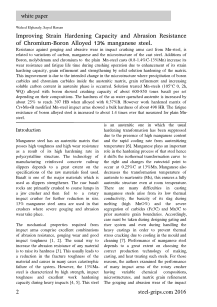Resistance against gouging and abrasive wear in impact crushing arms cast from Mn-steel, is related to variations of carbon, manganese and the microstructure of the cast steel. Additions of Boron, molybdenum and chromium to the plain Mn-steel casts (0.8-1.4%C-13%Mn) increase its wear resistance and fatigue life time during crushing operation due to enhancement of its strain hardeing capacity, grain refinement and strengthening by solid solution hardening of the matrix. This improvement is due to the intended change in the microstructure where precipitation of boron carbides and chromium carbides inside the austenitic matrix, grain refinement and increasing soluble carbon content in austenite phase is occurred. Solution treated Mn-steels (1050C, 2h, WQ) alloyed with boron showed crushing capacity of about 1200-1550 tones basalt per set depending on their compositions. The hardness of the as water quenched austenite is increased by about 25% to reach 397 HB when alloyed with 0.37%B. However work hardened matrix of Cr+Mo+B modified Mn-steel impact arms showed a bulk hardness of about 498 HB. The fatigue resistance of boron alloyed steel is increased to about 1.4 times over that measured for plain Mn-steel.
Login to Download full PDF Article...Improving Strain Hardening Capacity and Abrasion Resistance of Chromium-Boron Alloyed 13% manganese steel

